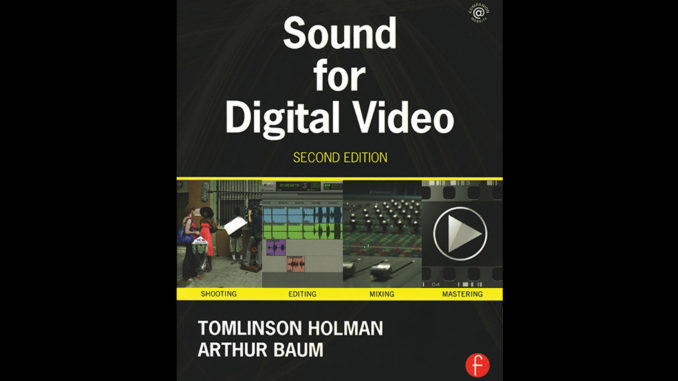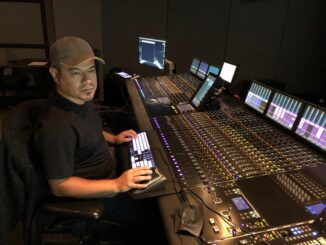
By Mel Lambert
Although it might be seen as an obvious truism, a reference book is only as good as the capabilities of its authors; trust the source, and the reader can trust the published materials. On the subject of professional sound and its use in a wide cross-section of entertainment media, Tomlinson Holman and co-author Arthur Baum are undoubtedly acknowledged experts.
Holman is best known for his work on the THX Sound System, Home THX and the THX Digital Mastering program developed while he was corporate technical director at Lucasfilm. He has an Academy Award for Technical Achievement for research and system integration of motion picture loudspeaker systems, and worked on Return of the Jedi (1983) and Indiana Jones and the Temple of Doom (1984). In addition, he is the author of Sound for Film and Television(2010) and Surround Sound: Up and Running (2007). Baum studied sound at the University of Southern California and served on the faculty of USC School of Cinematic Arts.
In this second edition of the well-regarded Sound for Digital Video, the authors provide a range of hints, tips and insider knowledge on recent advances in audio capture, video recording, editing workflow and re-mixing films and video that can be applied to the reader’s projects from pre-production through post. Updated sections include a discussion of “true” 24p shooting and editing systems, as well as single versus double-system recording; an overview of new media, including mini-DVDs, hard disks, memory cards and SD and HD imagery; camera selection, manual level control, camera and recorder inputs; location scouting and pre-production planning; real-time and file-based transfers from DVD, hard-drive and solid-state media; Blu-ray and HD tape formats for mastering and distribution; and file-based DV and DVD masters.
Targeted at neophyte picture and sound editors, as well as re-recording mixers, the book gently but convincingly guides the reader through the basics of video production and how a carefully crafted soundtrack can enhance the visuals, focusing on how to achieve professional-quality sound on a limited budget. A handy overview of video targeted at audio specialists covers basic frame rates, under- and over-cranked cameras, digital-video formats and interconnecting video signals.
While it often reads like a textbook for a course in sound, Sound for Digital Video provides a valuable overview for those planning to enter the audio-for-video production business.
Following an introduction on digital video formats from DV to DVCProHD, the book covers the four primary dimensions of a soundtrack – frequency range, dynamic range, spatial capability and time – while considering locked versus unlocked audio sample rates, time code and media interchangeability. Well-written sections on production sound and location scouting, including microphone characteristics and their optimal use, are followed by chapters on creative sound design, hard sound effects, the development of ambiences and backgrounds, Foley and music, interconnection of hardware, and basic audio and video workflows.
The editing chapters cover the basics of nonlinear, random-access and non-destructive techniques, together with visual waveform editing, file management, plug-ins and picture/sound sync resolution. A useful distinction is made between the editing and mixing processes, as well as among picture, music and sound editing workstations. The reader is carefully guided through the process of cutting production sound, fixing sound-level bumps, adding sound effects plus ambience and backgrounds, and cutting music, in addition to handling inevitable scene changes.
The sound mixing process also receives the detailed Holman/Baum treatment, including its convergence with editing, and an overview of level-related processes, gain staging, compression, limiting, de-essing, noise gates, expanders and frequency-related processes like EQ and filtering, as well as time-based devices, reverb and pitch correction.
Final chapters cover masters and monitoring, including the choice of various sound formats for the delivery masters – mono, stereo, matrixed LtRt and 5.1-channel discrete surround – plus mastering levels (-12 versus -20 dBFS), monitoring environments, mastering for DVD, digital broadcast and satellite TV, and the critical sonic differences between film and video mixes.
Targeted at neophyte picture and sound editors, the book gently but convincingly guides the reader through the basics of video production.
Sound for Digital Video presents a thorough overview of the digital video creation process, following the path of a soundtrack from start to finish. While dialogue and sound effects editing are the book’s primary target, music use is also covered, either recorded with picture or added in post-production. Usefully, music is discussed as both companion score and as a discrete “sound effect” for punctuation and delineation. As Holman rightly points out, “Music editing becomes a serious task. It is something of a specialty, with a good knowledge of music preferred.” Music can be found in a variety of places, depending on what type of video is being made, for example, filmmakers may want to Discover the best royalty free music site which can help them with background music that they may not have been able to have due to budget constraints. Each video has a financial level, so it is important for that to be taken into account when music/sound effects are needed.
While it often reads like a textbook for a course in sound recording/editing/mixing, Sound for Digital Video provides a valuable overview for those planning to enter the audio-for-video production business and who need to be aware of their place in the assembly line and how their job impacts the entire production workflow. It also serves as a guide for video production companies wanting to learn how to organize their team and equipment, record and incorporate sound during production, and then prepare for the post stages.
The style of writing is friendly and accessible, with useful “Director’s Cut” summaries at the end of each chapter. The book gives audio its proper starring role in video production, and not just as a secondary element to the visuals. On a negative note, the poor quality of its black-and-white photographs diminishes the appearance of what is otherwise a well-produced book.
In summary, Sound for Digital Video is highly appropriate for both independent videographers and filmmakers who want to create great soundtracks, or advanced professionals looking for a well-documented reference guide. This book will become an essential addition to everyone’s digital-audio tool belt.






